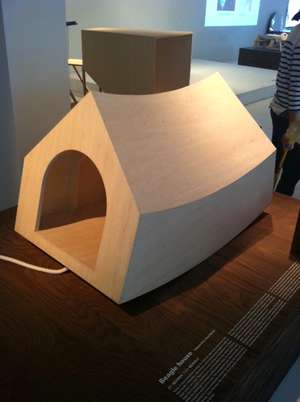
With Design Miami now held in Miami Beach, Craig Robins, the founder of the annual design fair, has had to work harder to keep crowds coming to the Design District across the water in Miami. Largely owned by Robins’ company, the District is preparing to welcome dozens of fashion retailers, some to new buildings—including at least one being designed by Leong Leong. But during Basel week, the attractions include installations by designer Luis Pons, a mural by the graffiti artist Retna on the facade of a temporary Louis Vuitton store, and, somewhat surprisingly, an exhibition of architecture for dogs.
 |
| Photo by Fred A. Bernstein MVRDV's beagle house on view in Miami's Design District. |
To a journalist looking for metaphors, "architecture going to the dogs" is almost irresistible. Except that the show is so good, it's hard to be a cynic. Kenya Hara, the art director of retailer Muji, curated the canine collection. Among the standouts are a gridded Boston Terrier apartment by Sou Fujimoto (you'll probably never own a Fujimoto, but now your dog can), a surprisingly cozy Bichon Frise pad by SANAA's usually hard-edged Kazuyo Sejima, and a cardboard Papillon playpen by Shigeru Ban. But the standout may be the iconic doghouse given a curved bottom that makes it rock—and, not incidentally, resemble Noah's ark—by MVRDV.
Elien Deceuninck is representing the Rotterdam firm in Miami, and said she designed the tiny Beagle building for love, not lucre. The plans will be posted on-line, for do-it-yourselfers, though the organizers of the show said they will also begin selling flat-pack versions of the doghouses next year. Deceuninck, meanwhile, is focused on the firm's plans for the next edition of the Floriade, the Dutch flower show, opening in 2022 (yes, 2022), on a manmade peninsula off Almere. Getting the terrain, the buildings, and their horticultural components right will require the whole decade, Deceuninck said, adding that she wishes more projects were developed on that kind of leisurely schedule—70 dog years.

Post a comment to this article
Report Abusive Comment